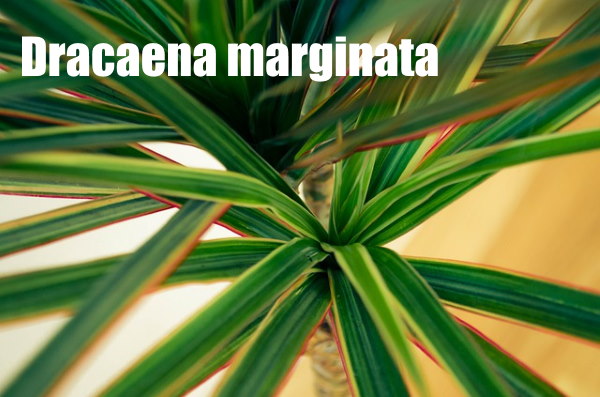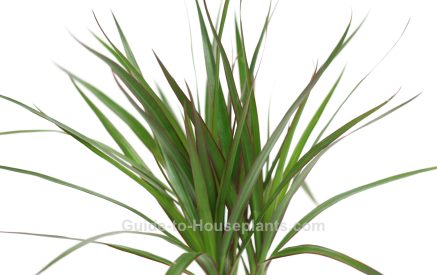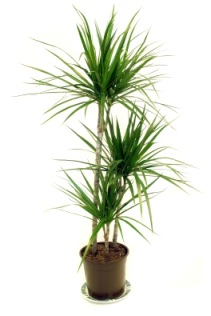Madagascar Dragon Tree
Madagascar dragon tree is a bold accent if you have the space. Its daring, upright form punctuates the decor like an exclamation point, adding excitement to any room.
Its care is easy. Find out how to prune, water and fertilize Dracaena marginata here.

Get to Know Dragon Tree Houseplant
Known botanically as Dracaena marginata, this Madagascar native will reach a height up to 6 ft (1.8 m) indoors. Dragon tree is slow-growing and will take a while to reach this height.
This beautiful tree starts out as a thick tuft of spiky leaves. As it grows, the lower leaves naturally fall, leaving a cluster of dramatic, spear-shaped leaves above a bare woody stem. Its narrow, red-edged leaves can grow about 12-16 in (30-40 cm) long.
Dracaena care is easy. Dragon tree thrives in average room conditions, tolerating dry indoor air and low light levels that are deadly to most plants. This dynamic house plant also handles changing temperatures and humidity levels. Just don't overwater. It will not tolerate soggy soil, which can cause root rot.
Caring for Dragon Tree Year-Round
Clean it up. Those tall, upright leaves tend to be dust-catchers. If possible, take the plant outdoors when the weather permits and gently spray the leaves with tepid water. Or wipe them off with a damp cloth.
Keep it short. Slow-growing, this exotic house plant will eventually reach 6 ft (1.8 m) tall indoors. You can control its height by simply cutting off the top.
Pruning tip: Prune dragon tree back in spring or early summer to control its growth. You can cut off the cane at any height. Within weeks, it will sprout a new cluster of leaves from where it was cut. Use clean, sharp pruners to avoid tearing or infecting the stem.
Take a stand. Give a young plant a boost by placing it on an indoor plant stand. The tall, spiky leaves of the dragon tree looks spectacular by itself on a pedestal stand. Or combine it with shrubby and trailing plants for contrast. Take a look at these new ways to display your indoor plants.
Repot in spring when roots become coiled in the container or grow out of the drainage holes. Always use fresh potting mix when you repot a plant; old potting mixes become compact over time and nutrients become depleted. Take care not to bury the stems -- keep the plant at the same soil level as before to prevent stem rot. Use a pot with drainage holes to prevent root rot.
Brown leaf tips are typically caused by dry soil, dry air, or hot, direct sunlight. You can snip them off, if you want.
Winter care: Dragon tree is an evergreen that won't go dormant, but growth will slow down during the fall and winter months because of fewer daylight hours. Reduce watering and stop fertilizing, then you can resume normal care in spring.
Something bugging your tree? Dragon tree typically shrugs off pests, although dry air may attract spider mites to its leaves. Faded, yellowing leaves and webbing between leaves indicate an infestation. Regular misting with water will do double-duty, raising the humidity and keeping those pests away. Scale insects are small, brown discs that may be found on the underside of leaves. You can pick them off or treat your tree with an insecticide.

Buying Tip
This popular Dracaena house plant is easy to find at garden centers. A few varieties are available.
The cultivar 'Tricolor' has green-and-cream stripes on its leaves with red margins and also goes by the name Rainbow Plant. 'Colorama' has similar coloring as 'Tricolor' with prominent red margins.
Dragon Tree Care Tips

Light: Bright, indirect light. Avoid direct sunlight in summer, which may cause dry, brown patches on leaves. Give your Dragon Tree a quarter turn every week to expose all sides to light for even growth.
Water: Keep soil lightly moist spring through fall, slightly drier in winter. Do not let soil get waterlogged, which can cause root rot. Drooping, yellow leaves are a sign of root rot. Use a pot with drainage holes to prevent soggy potting soil.
Humidity: Average room (around 40% relative humidity). Will tolerate dry air.
Temperature: Normal room temperatures (65-75°F/18-24°C). This tropical native doesn't like cold air, which can cause its leaves to fall off. Keep your tree away from heat/AC vents as well as blasts from windows and doorways in the winter.
Soil: Good-quality, all-purpose houseplant potting mix.
Fertilizer: Feed every 2 weeks in spring and summer with a balanced (10-10-10) liquid fertilizer diluted by half. Don't forget to feed your tree -- pale leaves are sometimes caused by too little fertilizer.
Propagation: Cut sections of the cane into 4-6-inch (10-15 cm) pieces and root them like stem cuttings. For best results, dip cut ends in rooting hormone powder before setting them in potting medium. Use a sterile medium, such as seed starting mix, or a half-and-half mix of peat moss-based mix and horticultural sand. Keep potting medium lightly moist and warm for roots to develop.


